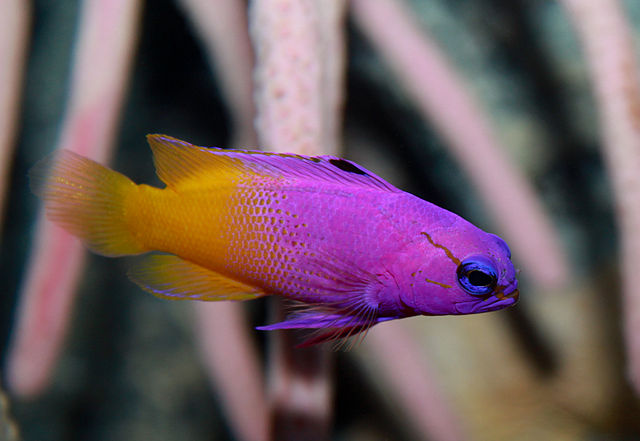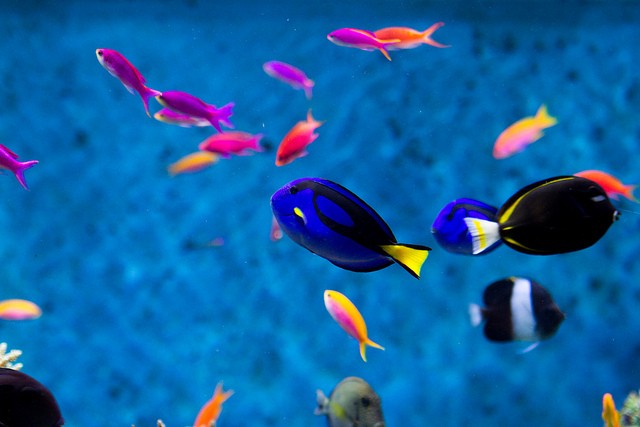The Royal Gramma Basslet is a popular fish for any reef tank due to their docile temperament, small size, and ease of care.
Their bright colouring and label as a cleaning fish make them a great choice for any aquarist looking to add some serious vibrancy to their tank. You may recognize this vivid little purple and yellow creature from Finding Nemo!

Royal Gramma are good for beginners, can live happily in a tank as small as 30 gallons, and are an excellent addition to any fish collection.
It is super important to know what’s what when it comes to your fishy friends, so we have put together a top guide for anyone looking to purchase a Royal Gramma.
Contents
Royal Gramma Appearance & Personality
The Royal Gramma, also called the Fairy Basslet, is native of warm, Caribbean waters and lives in coral reefs and rocky crevices.
They are cave dwellers, and love to make reef walls, overhangs, large coral, and sponge structures in their home.
Despite their eye-catching appearance, these fish are actually quite shy.
They will often stay hidden until they feel comfortable exploring an aquarium, and are more suitable for tanks without sharp lighting.
Personality
In spite of this shy nature, however, the Royal Gramma can still turn aggressive when it comes to territory.
Unless your tank is quite large and has plenty of rock and coral formations, these are fish in which only one should be kept per tank.
We mentioned that the Royal Gramma is a cleaner fish. This means that they help keep the tank clean of ectoparasites – nasty parasites that live on the scales of fish – and eat up any dead matter that the other tank inhabitants ignore – like leftover food.
Royal Gramma are a good method of keeping an ecosystem running cleanly.

Size
These aren’t a large fish. Usually, they will grow up to three inches in size. But there have been rare cases of Royal Gramma’s capping out at five inches.
Their small size makes them a good addition to most aquariums, though their placid nature can change to something more aggressive when put into a tank with fish much bigger or smaller than they are.
They also have some curious swimming habits that may alarm the uninformed. Royal Gramma will often swim slightly tilted, often parallel to whatever surface is closest. Sometimes they even swim completely upside down!
LifeSpan
Royal Gramma typically live between three to five years, but in the right circumstances, they can live much longer. Take care of your fishy friends and they will be around for a long time.
All around, the Royal Gramma is a widely available saltwater fish that is good for populated tanks and beginner saltwater aquarists.
Health Concerns
Resistant to most diseases that can infest aquariums, Royal Gramma are a hardy fish.
They are still vulnerable to Saltwater Fish Diseases though, so keep an eye out for lethargy, damaged and/or loss of coloration, and lack of appetite.
Fishlore.com has a great breakdown of common and less-than-common health issues that can crop up, and you can find it right here.
Royal Gramma Care
Tank Requirements
At minimum you want a 30 gallon tank for any Royal Gramma. Ideally, you only want one Royal Gramma per tank as well.
Even mated pairs should have a tank larger than a 30 gallon, with plenty of rocks, wood, coral, or decorations providing nooks, caves, and crannies for the fish to hide in.
Remember, these fish are shy despite their territorial nature. Keep them comfortable to minimize stress and you will have a happy aquarium.

While we’re on that… lighting and water temperature are important factors for Royal Gramma. They are a hardy breed, but to ensure a long, healthy life, it is best to take all steps possible.
Any lighting you pair with your tank should not be bright and sharp. Low intensity or blue-wash lights are your best friend.
If you do have a variety of shallow and deeper reef fish and/or coral that needs strong light, then invest in an automatic timer for your lights and have plenty of darker caves where your fish can hide during the bright time; this way, everyone is happy.
Water Requirements
Now, temperature is critical for tropical fish. As Royal Gramma are Caribbean natives, in the warm, shallow reefs of the Pacific Ocean, they need water at a constant temperature.
Water kept between 72 and 80 degrees Fahrenheit is the best range to keep your tank at.
Obviously, for saltwater fish, you need saltwater. And just as obviously, you can’t simply run out to the ocean with a bucket and start filling your tank with that. There are all sorts of bacteria, algae, parasites, and muck in the sea.
Nor can you fill the tank up with the garden hose and chuck a bunch of table-salt in there. You’ll need to buy specific marine reef salt mix to add to the water, plus an agent to remove chlorine.
Royal Gramma need clear, clean water with a pH between 8.1 and 8.4, and a gravity between 1.020 and 1.025. Ensure that you have the right tools to monitor your water levels!
Tank Set-Up
Before you even think about getting a Royal Gramma, ensure that you have hidey holes for them to scamper to once set free in their new home.
For the first few days – up to a week – they will be very timid and probably not too interested in food. After they feel more comfortable, they will start exploring the tank and eating on the regular.
If you are planning on adding a Royal Gramma, or any fish, to an established and already populated tank, then having a quarantine aquarium is a smart idea.
These tanks are great for helping fish calm down after being shipped all around the world, and are also good for you to ensure your new fish is healthy.
Once the quarantine period is done (one to two weeks is a recommended time), you can introduce your Royal Gramma to the tank!
The actual introduction process is just like any other fish. Using a sterilized container, remove the fish from the quarantine tank and place the container in your main tank – without tipping out the contents.
Let the fish adjust to any variations in temperature over a period of 5 – 10 minutes before gently releasing them into the tank.

A few helpful tips for making the transition easier:
- Feed all of the aquarium’s current occupants before introducing their new companion, as this will tone down their territorial instincts and make them less aggressive to a new tank mate.
- Add new decorations and possibly move around some of your current ones, as this disrupts any claimed territories of established fish and will tone down their aggression to a potential threat.
- If possible, add more than one fish to a new tank at a time; this prevents current fish from singling out a newcomer and harassing them. This does not mean getting more than four Royal Gramma!
- Adding live plants it a good way to minimize stress in an aquarium environment, and provides some nice cover for shy or stressed fish.
Tank Maintenance
Maintaining the tank is a vital part to keeping any aquarium healthy. Saltwater tanks take a bit more maintenance, and require a little more equipment to monitor.
You will need to know if ammonia is present in the tank, the pH and alkalinity levels, the nitrate levels, and the specific water gravity.
Generally, monitoring the above is what any aquarium hobbyist should do, alongside checking the temperature, maintaining the filter, and changing out 10% to 25% of the water at least once a month – more if you have a medium to high population tank.
Feeding Royal Gramma
Royal Gramma can eat a variety of different foods, making them a versatile fish that can settle in with many different kinds of tank mates.
Depending on whom you ask, they can be classed as a planktavore or carnivore, and they eat plankton, crustaceans, mysis shrimp, marine fish, and a variety of pellets and flakes.
To keep fishy friends in top health, it is a great idea to feed them a range of different foods. Royal Gramma can also become picky eaters, and rotating their food is a way to manage this behaviour.
Tank Mates
Royal Gramma are rather good fish for populated tanks. Really, so long as they are living with fish of a similar size and/or temperament, and have enough space and hidey holes, everything should be just dandy.
Avoid predatory fish, like lionfish, eels, and aggressive cichlids too, as they will go after your poor little Royal Gramma.
If you are dead-set on having more than one Royal Gramma, then make sure the tank is large enough for them to each stake out some territory. We recommend 100 gallons as a minimum sized tank if you want multiple Royal Gramma fish.
Male-Female pairs generally do okay together, but if they become a breeding pair, you will have to deal with more aggressive territorial behaviour and a spike in fish population if the babies survive. This can be a big problem down the line, unless you are a breeder, and is a situation you want to avoid.
As a general rule, fish of the same temperament and size do great with Royal Gramma. If you are just setting up your tank or looking for new tank mates for your Royal Gramma, then do a bit of research beforehand.

Pick the fish that will reach a similar size and are docile in nature.
Royal Gramma are also good neighbours to shrimp, snails, and clams, or any invertebrates (that they can’t fit in their mouths).
The Royal Gramma is a beautiful little fish that, due to their peaceful nature and fortitude, are perfect for those new to saltwater tanks. If you are considering expanding your tank’s community, then the Royal Gramma is definitely a fish to consider.
Do you own or plan on owning Royal Gramma?

